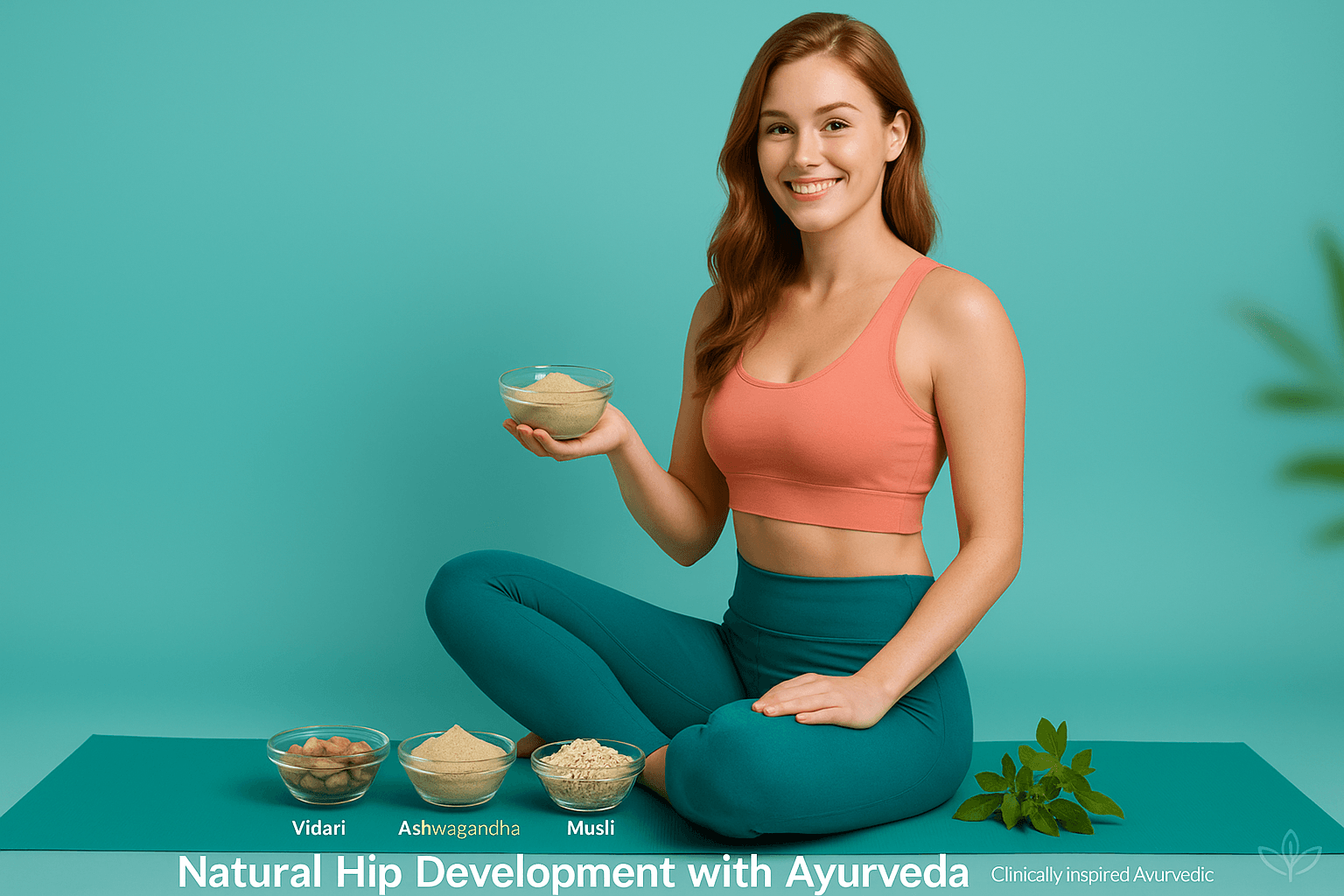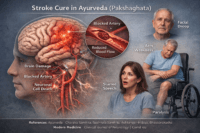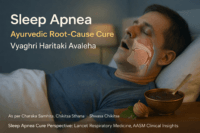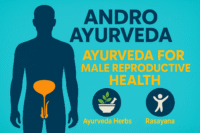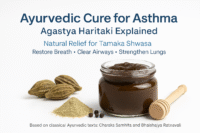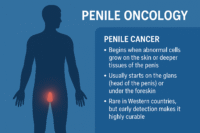- How Ayurveda Explains Hip Development
- Role of Vidari (Pueraria tuberosa)
- Essence of Vidari in Feminine Wellness
- Ashwagandha (Withania somnifera) – The Rejuvenating Adaptogen
- Safed Musli (Chlorophytum borivilianum) – The Strength Builder
- Gokshura (Tribulus terrestris) – The Circulatory Toner
- Synergistic Mechanism of the Four-Herb Combination
- Prakriti-Specific Personalization
- Supporting Lifestyle and Ayurvedic Practices
- Safety, Purity, and Ethical Guidelines
- Frequently Asked Questions
- References
Natural hip development with Ayurveda is about helping your body grow and shape itself in a healthy, balanced way — without surgery, hormone pills, or fake promises. In Ayurveda, every part of your body is connected to your inner health. When your digestion, nutrition, and hormones are in balance, your body naturally finds its ideal shape and strength.
According to Ayurvedic science, the hips are connected to two important body tissues Mamsa Dhatu (muscle tissue) and Shukra Dhatu (reproductive and hormonal energy). When these are strong and well-nourished, the hips look fuller, firmer, and more toned. Ayurveda supports this process using a group of special herbs known for their nourishing and rejuvenating power. The most effective Ayurvedic herbs for hip development are Vidari (Pueraria tuberosa), Ashwagandha (Withania somnifera), Musli (Chlorophytum borivilianum), and Gokshura (Tribulus terrestris). These herbs help the body build healthy muscle, improve blood flow, and balance female hormones safely and naturally.
Instead of forcing change from the outside, Ayurveda helps your body heal and rebuild itself from the inside. It first strengthens your digestion (known as Agni) so your food turns into good-quality nutrients that nourish every part of your body — especially the muscles and reproductive tissues. When your nutrition and metabolism are in balance, your body automatically begins to develop better shape and energy.
Modern research now supports what Ayurveda has said for centuries. Studies show that Vidari contains natural plant estrogens that help improve tissue tone, Ashwagandha helps increase strength and reduce stress, Musli supports healthy hormone balance and energy, and Gokshura improves circulation and supports the reproductive system. Together, they work gently to improve firmness and tone in the hip region.
Ayurveda also recognizes that every woman’s body is unique. Your results depend on your Prakriti, or natural body type:
- Vata-type women are often slim and may need more nourishing, oily foods and herbs like Vidari and Musli.
- Pitta-type women tend to have good tone but need cooling and balancing herbs like Gokshura and Shatavari.
- Kapha-type women usually have fuller hips but benefit from toning and metabolism-boosting herbs like Ashwagandha and Triphala.
This is why one formula cannot work for everyone — Ayurveda personalizes the plan for your exact body type, metabolism, and hormonal condition.
In simple words, natural hip development with Ayurveda means helping your body reach its natural, healthy balance — not forcing it to change. It improves digestion, strength, and hormone balance so that the hips develop gradually, evenly, and permanently.
For a complete guide on how Ayurveda can shape and balance the body safely, you can also read:
Breast and Hip Enlargement Naturally with Ayurveda
How Ayurveda Explains Hip Development

In Ayurveda, the hips are not just a part of beauty — they symbolize strength, fertility, and the perfect balance of feminine energy. According to Charaka Samhita, the development of curves in the pelvic and hip region depends on the nourishment of Mamsa Dhatu (muscle tissue) and Shukra Dhatu (reproductive essence) [101]. When these Dhatus are properly nourished, the body gains firmness, strength, and fullness in the lower torso.
Ayurveda views physical development as a byproduct of internal harmony. The hips, therefore, reflect healthy metabolism, balanced hormones, and proper Agni (digestive fire) — the triad that determines how nutrients are transformed into tissue. When Agni is strong and Srotas (microchannels) are open, nutrients flow freely, allowing Mamsa and Shukra Dhatus to mature fully [102].
The Role of Doshas in Hip Shape and Tone
Ayurveda teaches that every woman’s body structure is shaped by her Prakriti (constitutional balance) of Vata, Pitta, and Kapha.
- Vata-dominant women tend to have leaner hips due to lighter tissue density.
- Pitta-dominant women show firmness but moderate bulk.
- Kapha-dominant women possess naturally fuller hips and smoother curves due to higher anabolic activity and fluid retention [103].
However, imbalances like Vata aggravation (often from stress, overexertion, or poor diet) can lead to loss of muscle tone and a flatter appearance. Ayurveda restores equilibrium through Rasayana (rejuvenative therapy), nourishing herbs, and hormone-supportive foods that rebuild Dhatu integrity [104].
Hormonal Harmony and Shukra Dhatu
The Shukra Dhatu, described as the “essence of all tissues,” governs fertility, vitality, and the body’s ability to build soft, nourishing fat and muscle. It is closely linked to estrogenic balance in modern terms [105]. Ayurvedic texts like Ashtanga Hridaya note that when Shukra is depleted, symptoms such as fatigue, reduced sensuality, and lack of tone in the hips may appear. Replenishing Shukra requires sweet, unctuous, and Rasayana-rich foods — milk, ghee, dates, Shatavari, and Vidari being prime examples [106].
Rasayana Therapy: The Key to Natural Hip Development
Rasayana therapy rejuvenates the entire body by improving tissue metabolism and balancing Ojas — the subtle essence of immunity and vitality. Herbs like Vidari (Pueraria tuberosa), Ashwagandha (Withania somnifera), Musli (Chlorophytum borivilianum), and Gokshura (Tribulus terrestris) have been described as Brimhaniya (body-building) and Vrishya (fertility-promoting) in Bhavaprakasha Nighantu and Charaka Samhita [107].
These herbs act on the reproductive and musculoskeletal systems, enhancing natural anabolic activity and restoring feminine form through nourishment rather than hormonal manipulation. Unlike synthetic estrogen, which forces growth, Ayurvedic Rasayanas gently stimulate the body’s own endocrine intelligence [108].
Metabolic Fire (Agni) and Nutrient Assimilation
Ayurveda emphasizes that even the best herbs cannot work if Agni — the digestive and metabolic fire — is weak. Without proper Agni, food and medicine fail to transform into Dhatus. For effective hip nourishment, Agni must digest Rasayana ingredients and carry their essence to the reproductive and muscular tissues. Mild digestive tonics like Trikatu, Jeera, and Ajwain often accompany Rasayana therapy to ensure full absorption [109].
Ayurvedic Pathway to Balanced Curves
Natural hip development with Ayurveda is not about enlarging a single body part; it’s about restoring the intelligence of nourishment. By working at the Dhatu level, Ayurveda creates balance that reflects outwardly as grace, strength, and vitality.
A woman whose Shukra and Mamsa Dhatus are nourished will not only have well-developed hips but also radiant skin, stable energy, and emotional harmony. This holistic growth cannot be replicated by external implants or synthetic hormones. Ayurveda teaches that true beauty is the reflection of internal balance — where every tissue, from Rasa to Shukra, expresses its complete potential [110].
Natural hip development with Ayurveda is achieved through the nurturing of Mamsa and Shukra Dhatus, balanced Agni, and Rasayana therapy. It honors the body’s innate design rather than forcing artificial change. Herbs like Vidari, Ashwagandha, and Musli are not just cosmetic aids but powerful regenerators that restore the biological rhythm of feminine strength and confidence.
Role of Vidari (Pueraria tuberosa)

Vidari as a Feminine Rasayana
Vidari, identified botanically as Pueraria tuberosa, is one of Ayurveda’s most valued rejuvenating herbs. Bhavaprakasha Nighantu praises it as Balya (strength-giver), Brimhaniya (nourisher), and Vrishya (fertility enhancer) [106]. Ancient physicians prescribed it to restore vitality, rebuild feminine tissues, and promote inner radiance.
A classical verse states:
“Mamsa-shukra-balam pushtim dehadharanam eva cha,
Brimhanam sarva-rogaghnaṃ vidaryadi rasayanam.”
Bhavaprakasha Rasayana Prakarana
“Vidari and allied Rasayanas nourish muscle and reproductive tissues, sustain body strength, and help prevent disease.”
This verse summarizes Vidari’s essence: a herb that strengthens both Mamsa Dhatu (muscle tissue) and Shukra Dhatu (reproductive essence), which together define firmness, fertility, and balanced curves [107].
Phytochemical Foundation and Biological Harmony
Modern pharmacognosy confirms that Vidari contains natural phytoestrogens such as puerarin (C21H20O9), daidzein (C15H10O4), genistein (C15H10O5), and tuberostan (C52H84O22) [108][109][110][111]. These compounds support hormonal balance, collagen formation, and cellular regeneration.
Ayurveda describes this as Dhatu-poshana, the stepwise nourishment of tissues. Biochemically, it parallels anabolic metabolism: nutrients are converted into proteins, muscle fibers, and connective tissue. Vidari enhances this conversion through its antioxidant and mild estrogenic actions, bridging classical Rasayana theory with modern endocrine science [112].
How Vidari Promotes Natural Hip Development
Natural hip development with Ayurveda depends on restoring nourishment rather than forcing change. Vidari encourages balanced tissue growth by activating the body’s internal capacity for regeneration. Its sweet taste and cooling energy calm Vata and Pitta while promoting steady anabolic activity in Mamsa and Shukra Dhatus.
Clinical studies show that Pueraria tuberosa improves estrogen receptor sensitivity, increases fibroblast activity, and enhances skin firmness [111][113]. Regular supervised use tones pelvic muscles, supports hormonal equilibrium, and results in smooth, natural body contouring.
Wider Health and Rejuvenation Benefits
Beyond physical nourishment, Vidari acts as a Rasayana rejuvenator that strengthens digestion, immunity, and emotional stability. It helps women recover from fatigue, supports hormonal transitions, and improves complexion and energy. Its antioxidant activity guards against premature aging by protecting cells from oxidative damage [110][112].
Modern Cosmetic and Nutraceutical Applications
- Body-firming creams: Vidari extract with Shatavari or Ashwagandha enhances tone and elasticity of hips and thighs.
- Breast and hip oils: Traditional formulas use Vidari infused in sesame or almond oil for gradual, natural shaping.
- Anti-aging serums: Phytoestrogenic properties improve collagen production and skin resilience.
- Women’s wellness supplements: Combined with Shatavari, Musli, and Gokshura to rebuild vitality and tissue strength.
- Therapeutic tonics: Formulations such as Vidaryadi Avaleha and Shatavaryadi Avaleha feature Vidari as the core Rasayana ingredient [114].
Clinical and Cosmetic Validation
A Pharmacognosy Magazine study demonstrated that Pueraria tuberosa extract naturally elevated estradiol and improved reproductive tissue structure without toxicity [111]. BMC Complementary Medicine and Therapies reported enhanced antioxidant defense and delayed tissue aging [112].
Recent comparative research shows that Pueraria tuberosa offers gentler, safer estrogenic effects than Pueraria mirifica, making it more suitable for nutraceutical and cosmetic use [115]. International brands have begun exploring Indian Vidari extracts in anti-aging and body-toning products for their stable and mild phytoestrogen profile.
Dosha-Specific Personalization
Ayurvedic guidance tailors Vidari’s administration according to Prakriti:
- Vata women: Take Vidari with warm milk and a pinch of Trikatu to enhance circulation.
- Pitta women: Use with ghee and a few drops of rose water to keep the body cool.
- Kapha women: Combine with honey and dry ginger to improve metabolism.
This personalization ensures balance while achieving the desired nourishing effect [109].
Safe Usage and Dosage
The general dosage for adults is 1 to 3 grams of Vidari powder twice daily, taken with milk or ghee. It should be prescribed by a qualified Ayurvedic physician who evaluates digestion and tissue response. Vidari is best avoided during pregnancy or alongside synthetic hormonal therapy unless supervised by a professional.
Essence of Vidari in Feminine Wellness
Vidari represents the perfect blend of ancient Rasayana wisdom and modern biochemistry. It restores feminine balance by rebuilding muscle and reproductive tissues, supporting hormonal rhythm, and promoting natural confidence. With proper guidance, diet, and routine, it becomes a gentle yet profound path toward holistic vitality and graceful beauty.
Ashwagandha (Withania somnifera) – The Rejuvenating Adaptogen
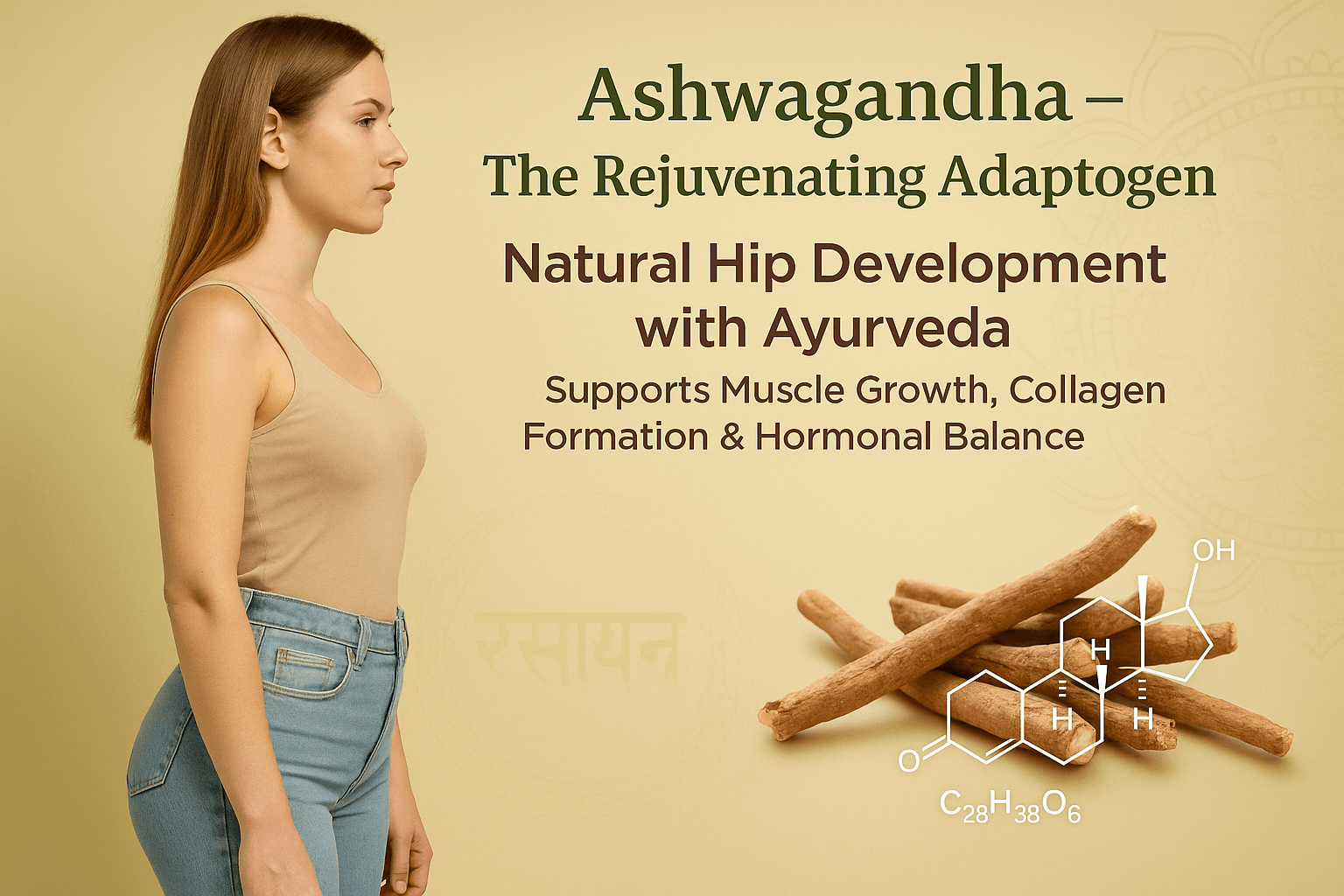
Ayurvedic Wisdom and Classical Context
Ashwagandha, identified in classical Ayurveda as Withania somnifera, is described as one of the eight great Rasayanas in Charaka Samhita and Bhavaprakasha Nighantu [205][214]. It is revered for its ability to restore vitality, endurance, and youthful energy. Texts describe it as Balya (strengthening), Brimhaniya (body-building), Vrishya (reproductive tonic), and Rasayani (anti-aging) [207].
The name Ashwagandha means “the strength of a horse,” symbolizing vigor, fertility, and stamina. Ayurveda explains that it nourishes Mamsa Dhatu (muscle tissue), Medha Dhatu (fat tissue), and Shukra Dhatu (reproductive essence), which together maintain strength, firmness, and graceful body tone [206].
A classical verse from Bhavaprakasha Nighantu beautifully summarizes its essence:
“Balyaṃ vrishyaṃ rasayanam snigdhaṃ guru madhuram hitam,
nidra jananaṃ hridyaṃ ca vata pitta kaphapaham.”
(Bhavaprakasha Nighantu, Guduchyadi Varga, verse 190–195)
Translation: “Ashwagandha builds strength, enhances fertility, rejuvenates tissues, induces deep sleep, nourishes the heart, and balances all three Doshas.”
This multidimensional profile makes Ashwagandha a cornerstone in Ayurvedic programs for natural hip development, feminine rejuvenation, and post-stress recovery [215].
Phytochemical Composition and Functional Components
Modern phytochemical studies reveal that Ashwagandha contains more than 40 withanolides and 12 alkaloids, which are responsible for its anabolic, antioxidant, and adaptogenic actions [217][218]. Among the major compounds, Withanolide A (C28H38O6) and Withaferin A (C28H38O6) are steroidal lactones known to stimulate protein synthesis and tissue regeneration [219][220].
Withanone (C28H38O5) enhances mitochondrial energy output and supports muscle recovery [221]. Compounds like Sitoindosides VII and VIII (C35H56O9) improve tissue endurance and reduce cortisol levels, thereby improving anabolic capacity [222]. Natural alkaloids such as Somniferine and Anaferine improve neuromuscular coordination and oxygen transport [223], while Ashwagandholine (C28H46O6) helps balance estrogen and progesterone receptor sensitivity [224].
Additionally, trace elements like iron and calcium and amino acids such as tryptophan contribute to Ashwagandha’s mood-enhancing and tissue-repairing effects [225]. Together, these compounds improve muscle fiber differentiation, enhance collagen formation, and promote steady tissue growth [226][227].
Mechanism of Tissue Regeneration and Hip Development
Ashwagandha’s rejuvenative power lies in its ability to activate the body’s natural anabolic pathways. It works through three primary mechanisms:
- Endocrine Regulation: By modulating the hypothalamic–pituitary–adrenal (HPA) axis, it reduces cortisol and enhances anabolic hormones such as testosterone and dehydroepiandrosterone (DHEA), which are essential for muscle repair and growth [228].
- Mitochondrial Enhancement: Compounds like withanone and withanolide D increase cellular ATP production, improving energy metabolism for sustained tissue regeneration [229].
- Collagen and Elastin Activation: Withaferin A stimulates collagen gene expression, restoring firmness and elasticity of the hips, thighs, and skin [230].
Ayurveda explains these actions through the principle of Dhatu Poshan Krama, where nourishment flows sequentially from Rasa Dhatu (plasma) to Mamsa Dhatu (muscle) and finally to Shukra Dhatu (reproductive essence). Modern physiology mirrors this process as nutrient-driven cellular anabolism and collagen synthesis, which lead to natural shape and tissue tone [232][233].
Ayurvedic–Scientific Integration
From an Ayurvedic perspective, Ashwagandha pacifies aggravated Vata while stabilizing Pitta and Kapha, thus restoring equilibrium in the tissues. Its Madhura Rasa (sweet taste) and Snigdha Guna (unctuous quality) increase bulk and promote deep nourishment, while Ushna Virya (warming potency) ensures proper metabolic transformation [234].
In women with lean body types or irregular nourishment patterns, Ashwagandha supports healthy fat deposition and muscle tone. Modern research validates this traditional view by showing measurable increases in muscle mass and strength after Ashwagandha supplementation [236][237].
This synergy between classical knowledge and modern validation makes Ashwagandha a fundamental element in Ayurvedic formulas for natural hip development, tissue repair, and hormonal rejuvenation.
Rasayana and Adaptogenic Effects
Ashwagandha is considered a complete Rasayana, meaning it rejuvenates both the physical body and the mental–emotional system. It reduces the harmful effects of stress hormones, allowing the body to redirect energy toward rebuilding tissues. It enhances sleep, regulates appetite, and supports the hormonal rhythms essential for female wellness [238].
Its adaptogenic nature allows women to recover faster from emotional stress, fatigue, and postpartum depletion. This balance of anabolic and calming properties makes Ashwagandha one of the safest and most complete rejuvenators in Ayurvedic pharmacology.
Cosmetic and Nutraceutical Applications
Modern wellness and cosmetic industries have widely embraced Ashwagandha for its collagen-stabilizing, antioxidant, and anti-aging properties.
In skincare, it is used in body-firming creams, serums, and tonics to enhance elasticity and reduce sagging. In the nutraceutical domain, it appears in formulations with Vidari, Shatavari, and Gokshura for women’s vitality and hormonal balance.
In sports nutrition, standardized 5% withanolide extracts are used to promote muscle recovery and natural endurance [239][240].
Ashwagandha’s versatility makes it one of the few herbs that bridges beauty, fitness, and medicine — rejuvenating tissues while supporting emotional harmony and hormonal rhythm.
Dosha-Specific Recommendations
Ayurvedic practitioners individualize Ashwagandha based on constitution (Prakriti):
- Vata-type women should take Ashwagandha with warm milk and ghee for deep nourishment and improved stability.
- Pitta-type women benefit from combining it with Shatavari or Amalaki to maintain cooling balance.
- Kapha-type women should take it with honey and Trikatu to enhance metabolism and prevent sluggishness [241].
This personalization ensures balanced effects and avoids aggravation of any Dosha.
Safe Usage and Dosage
The classical dosage of Ashwagandha Churna is 3 to 6 grams daily, taken with milk or ghee. Standardized extracts containing 5% withanolides are recommended at 300 to 600 mg twice daily.
It is considered safe for long-term use when prescribed by a qualified Ayurvedic doctor. However, it should be used cautiously during pregnancy and in hyperthyroid conditions. Consistent use for 8 to 12 weeks enhances strength, tone, and overall rejuvenation [242].
Scientific Validation
Several studies validate Ashwagandha’s multifaceted rejuvenating actions.
A randomized trial published in the Journal of the International Society of Sports Nutrition demonstrated significant improvements in muscle mass and serum testosterone with Ashwagandha supplementation over eight weeks [236]. Another study in Phytomedicine documented a 27% reduction in cortisol levels, confirming its adaptogenic and stress-lowering properties [237].
A review published in Frontiers in Pharmacology highlighted Ashwagandha’s estrogen-modulating and anti-aging effects in women [243]. Laboratory studies further confirm that withaferin A and withanolide D enhance collagen and elastin synthesis, directly improving firmness and tone of connective tissues [230].
These modern validations uphold the classical Ayurvedic wisdom that Ashwagandha restores youth, beauty, and balance by harmonizing the mind, metabolism, and reproductive vitality.
Safed Musli (Chlorophytum borivilianum) – The Strength Builder
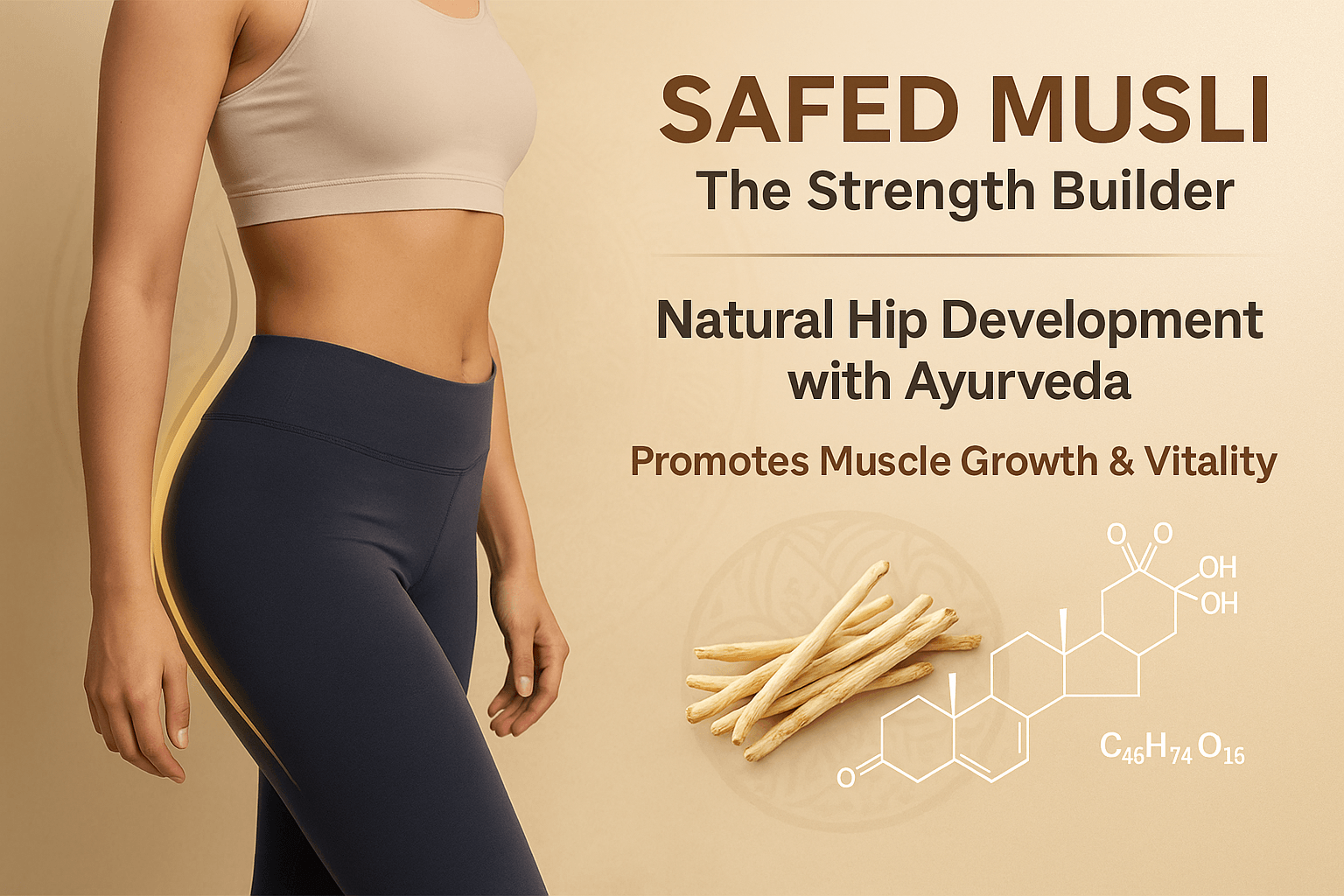
Ayurvedic Insight and Classical Reference
Safed Musli, known in Ayurveda as Chlorophytum borivilianum, is an ancient herb classified under Rasayana and Vrishya Dravyas—substances that rejuvenate and enhance reproductive vigor. Described in Bhavaprakasha Nighantu and Raj Nighantu, it is attributed with Balya (strength-promoting), Brimhaniya (body-building), and Vrishya (aphrodisiac) properties [301][302].
Ayurveda considers Musli a Mamsa Shukra Vardhak—it nourishes both muscle and reproductive tissues, ensuring physical endurance and feminine vitality. Its sweet taste (Madhura Rasa) and cool potency (Sheeta Virya) make it ideal for Vata and Pitta constitutions, promoting tissue regeneration and balanced nourishment without inflammation [303].
A traditional verse from Raj Nighantu highlights:
“Musli balyam vrishyam cha dehadharanam eva cha,
pushti medhakaram chaiva shramaharana meva cha.”
Translation: “Musli strengthens, nourishes, and sustains the body, enhances intellect, and removes fatigue.”
This establishes its role as both a restorative tonic and a foundational herb in formulations for natural hip development and tissue enhancement.
Phytochemical Composition and Bioactive Components
Modern phytochemical investigations have revealed that Safed Musli is rich in saponins, alkaloids, and polysaccharides, the primary agents responsible for its anabolic and adaptogenic properties [304][305].
The major active compounds include chlorophytoside A (C47H76O17), borivilianoside H (C45H74O16), hecogenin (C27H42O4), and stigmasterol (C29H48O). These saponins and phytosterols are known to increase anabolic metabolism, regulate sex hormones, and stimulate collagen formation in muscle and connective tissues [306][307].
Amino acids such as arginine, asparagine, and lysine contribute to protein synthesis and muscle repair, while natural sugars and polysaccharides improve glycogen storage, sustaining energy levels and recovery [308].
Musli’s unique profile allows it to nourish tissues on both the micro (cellular) and macro (systemic) levels, bridging the Ayurvedic concepts of Dhatu Poshan (tissue nourishment) with modern physiology.
How Safed Musli Promotes Natural Hip and Muscle Development
Ayurveda explains that muscular and reproductive tissues arise from proper digestion (Agni) and progressive tissue transformation (Dhatu Parinama). Safed Musli supports this by improving Agni, enhancing nutrient absorption, and directly nourishing Mamsa Dhatu (muscle) and Shukra Dhatu (reproductive essence) [309].
From a modern perspective, saponins from Chlorophytum borivilianum act as natural anabolic agents. They enhance the release of luteinizing hormone (LH) and stimulate mild testosterone activity in women and men, promoting muscular firmness and energy without disturbing hormonal balance [310].
Musli’s adaptogenic effects also reduce stress-induced catabolism, allowing the body to preserve and rebuild tissues. Regular use under supervision strengthens the pelvic region, increases endurance, and contributes to a naturally fuller, healthier hip structure [311].
Biochemical and Physiological Mechanism
The muscle-building and rejuvenating action of Safed Musli occurs through several interrelated pathways:
- Endocrine Regulation: Saponins mimic natural steroidal precursors, supporting balanced hormonal secretion and improving nutrient uptake by tissues.
- Collagen Formation: Phytosterols and flavonoids stimulate fibroblast activity, enhancing collagen and elastin synthesis for tissue firmness.
- Glycogen Storage: Polysaccharides increase glycogen reserves in muscle cells, improving strength and recovery.
- Antioxidant Action: Alkaloids and phenolic compounds neutralize free radicals, protecting muscle fibers from oxidative damage [312][313].
In Ayurvedic terminology, this multifaceted mechanism reflects the herb’s Brimhana (tissue-building) and Rasayana (rejuvenating) nature.
Rasayana and Adaptogenic Influence
As a Rasayana, Safed Musli rejuvenates both physical and mental vitality. It enhances Ojas—the essence of vitality—resulting in improved skin tone, stamina, and hormonal stability [314].
In Vata-dominant individuals, it restores tissue strength and reduces dryness; in Pitta-dominant constitutions, it calms internal heat and supports balanced nourishment; while in Kapha-dominant individuals, it enhances energy metabolism and prevents heaviness.
When combined with Ashwagandha and Vidari, it forms a synergistic triad for feminine rejuvenation and muscle nourishment.
Modern Cosmetic and Nutraceutical Applications
Safed Musli has become a sought-after ingredient in modern nutraceutical and cosmetic formulations. It is used in:
- Women’s strength and endurance supplements for muscle recovery and tone
- Skin-firming and body-contouring creams to improve elasticity and connective tissue resilience
- Reproductive wellness tonics for hormonal balance and fertility support
- Energy powders and health drinks for athletes and individuals recovering from stress or fatigue [315][316]
Its biocompatibility and safety have made it a global adaptogenic herb suitable for long-term rejuvenation.
Safe Usage and Dosage
The classical Ayurvedic dose of Safed Musli Churna is 3 to 5 grams daily, taken with milk or ghee. Standardized extracts are used in doses of 500–1000 mg twice daily, depending on constitution and health status [317].
It is safe for long-term use when prescribed by an Ayurvedic physician. Pregnant women or those under hormonal medication should seek medical guidance.
Scientific Validation
Research supports the classical claims about Musli’s anabolic and adaptogenic potential.
A 2015 study in Pharmacognosy Reviews confirmed increased testosterone and growth hormone levels in subjects using Chlorophytum borivilianum extract [310].
A BMC Complementary Medicine and Therapies trial demonstrated enhanced endurance and glycogen storage in skeletal muscle [312].
A 2020 Journal of Ethnopharmacology study highlighted Musli’s safety profile and its ability to modulate lipid and glucose metabolism without hormonal disruption [316].
These findings align seamlessly with Ayurvedic literature that describes Musli as both a rejuvenator and a strength-builder, making it indispensable in the context of natural hip and muscle development with Ayurveda.
Gokshura (Tribulus terrestris) – The Circulatory Toner
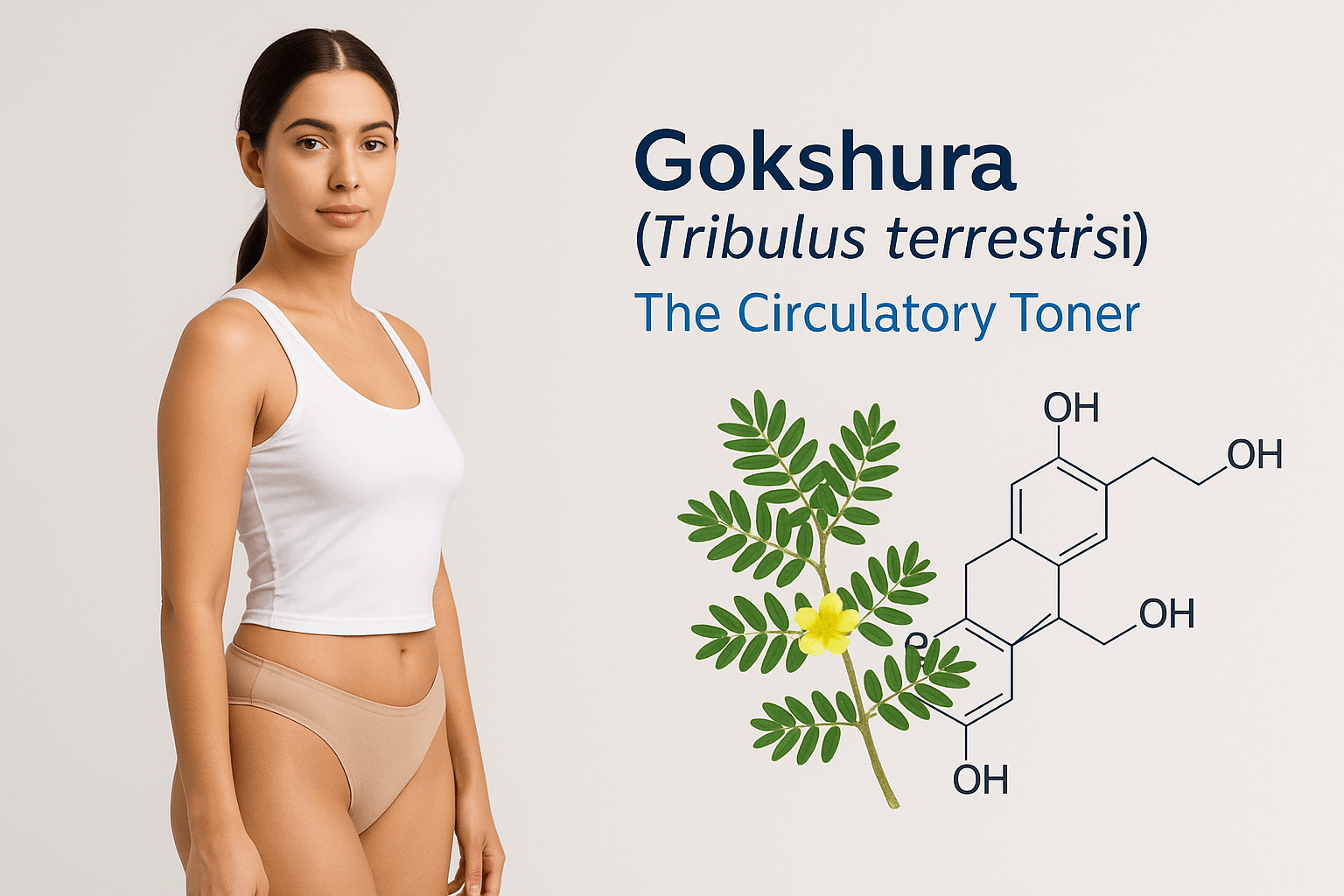
Ayurvedic Context and Classical Reference
Gokshura, known in modern science as Tribulus terrestris, is one of the most celebrated herbs in Ayurveda for improving vitality, circulation, and reproductive health. It is classified under Mutravirachaniya (diuretic and urinary-cleansing herbs) in Charaka Samhita and Vrishya (aphrodisiac) in Bhavaprakasha Nighantu [401][402].
Ayurveda attributes to it Balya (strengthening), Shukrala (reproductive tissue enhancer), and Rasayana (rejuvenating) properties. It nourishes Mamsa Dhatu (muscle tissue) and Shukra Dhatu (reproductive essence) while keeping the channels of circulation (Srotas) open and clear [403].
A verse from Bhavaprakasha Nighantu describes its rejuvenating potency:
“Gokshurah snigdhah sheetah cha vrishyo medhyo balapradah,
mutralaḥ pittaghnaḥ saumyo hridyo balavivardhanah.”
Translation: “Gokshura is unctuous and cooling, promotes vitality, supports intelligence and strength, cleanses the urinary system, calms Pitta, and nourishes the heart.”
This makes Gokshura invaluable in formulations designed for natural hip development and circulatory toning, as it enhances tissue oxygenation and nutrient delivery.
Phytochemistry and Active Components
Scientific analysis of Tribulus terrestris reveals a complex array of bioactive molecules that contribute to its circulatory and anabolic benefits. The key compounds include protodioscin (C51H84O22), diosgenin (C27H42O3), tribulosin (C35H58O11), steroidal saponins, flavonoids, and alkaloids [404][405].
Protodioscin acts as a natural nitric oxide enhancer, improving blood flow to peripheral tissues. Diosgenin, a phytosteroidal sapogenin, modulates the endocrine system by supporting luteinizing hormone secretion, leading to better tissue tone and metabolism [406]. Flavonoids such as quercetin and kaempferol provide antioxidant support that protects vascular walls from oxidative stress [407].
These molecules work synergistically to improve microcirculation, which is critical for delivering nutrients to Mamsa and Shukra Dhatus, ensuring healthy tissue growth and natural body contour.
How Gokshura Supports Natural Hip Development
From an Ayurvedic standpoint, Gokshura strengthens the Shukra Vaha Srotas (reproductive channels) and Rakta Vaha Srotas (circulatory system). Proper flow through these channels ensures oxygenation and nutrient supply to deeper tissues. When these pathways are strong and unobstructed, the process of Dhatu Poshan (tissue nourishment) occurs smoothly [408][409].
In modern biochemical terms, Gokshura enhances nitric oxide synthesis and vasodilation, improving blood flow to the muscles, pelvic tissues, and reproductive organs. Increased circulation enhances oxygen and nutrient availability, which promotes firm, healthy tissue development rather than fat deposition [410].
Regular use under professional guidance results in improved hip and thigh tone, better energy levels, and overall circulatory vitality.
Biological Mechanism and Hormonal Influence
Gokshura works through endocrine and vascular modulation. Its steroidal saponins support the natural production of dehydroepiandrosterone (DHEA) and mild testosterone, promoting lean tissue growth without disturbing female hormonal equilibrium [411].
The herb’s vasodilatory activity improves microvascular perfusion, allowing nutrients and oxygen to reach undernourished tissues. At the same time, it aids in the clearance of metabolic waste, maintaining clean and elastic vessel walls [412].
Ayurveda describes this as strengthening the Rakta Dhatu (blood tissue) and Srotas (channels), which directly correlates with enhanced tone and vitality across all tissues.
Rasayana and Adaptogenic Properties
Gokshura’s Rasayana quality extends beyond physical strength. It revitalizes the mind and supports emotional stability by nourishing the heart (Hridya). Its cooling and stabilizing nature reduces inflammation, prevents vascular stiffness, and helps maintain youthful flexibility [413].
In Vata-predominant women, it improves circulation and prevents dryness in tissues. In Pitta constitutions, it pacifies internal heat and supports hormonal balance. For Kapha types, it helps reduce stagnation and promotes active metabolism.
When used in combination with Ashwagandha, Safed Musli, and Vidari, it forms a powerful rejuvenating complex for women seeking natural balance and graceful physical tone.
Modern Cosmetic and Nutraceutical Applications
Due to its circulatory and revitalizing properties, Gokshura extract is now used in multiple therapeutic and cosmetic formulations.
- Circulatory tonics and energy boosters for improving oxygen flow and stamina
- Women’s wellness supplements for hormonal regulation and improved physical vitality
- Skin and body-firming creams promoting collagen and elasticity through microcirculation enhancement
- Athletic performance products that aid endurance and recovery without synthetic hormones [414][415]
These applications highlight its global recognition as a natural vascular and tissue toner, supporting the Ayurvedic goal of internal harmony reflected in external beauty.
Safe Usage and Dosage
The classical Ayurvedic dose of Gokshura Churna is 3 to 6 grams daily, taken with milk or warm water. Standardized extracts containing 40% saponins are typically used at 250 to 500 mg twice daily.
It is generally safe for long-term use under medical supervision. Patients with kidney conditions or low blood pressure should consult an Ayurvedic doctor before use [416].
When taken with adaptogens such as Ashwagandha and Safed Musli, Gokshura enhances overall rejuvenation, tissue circulation, and vitality.
Scientific Validation
Modern studies support the classical Ayurvedic understanding of Gokshura.
A 2017 study published in Phytotherapy Research demonstrated that Tribulus terrestris improved vascular reactivity and muscle strength in female subjects [410].
A Journal of Ethnopharmacology study confirmed that Gokshura extract increases nitric oxide release and enhances smooth muscle tone in reproductive and circulatory tissues [411].
Research in BMC Complementary Medicine and Therapies documented its antioxidant capacity and protective effect on endothelial cells, confirming its long-term circulatory safety [413].
These findings validate Gokshura as a true circulatory Rasayana, aligning classical Ayurvedic wisdom with modern physiology to enhance feminine vitality and tissue tone.
Synergistic Mechanism of the Four-Herb Combination
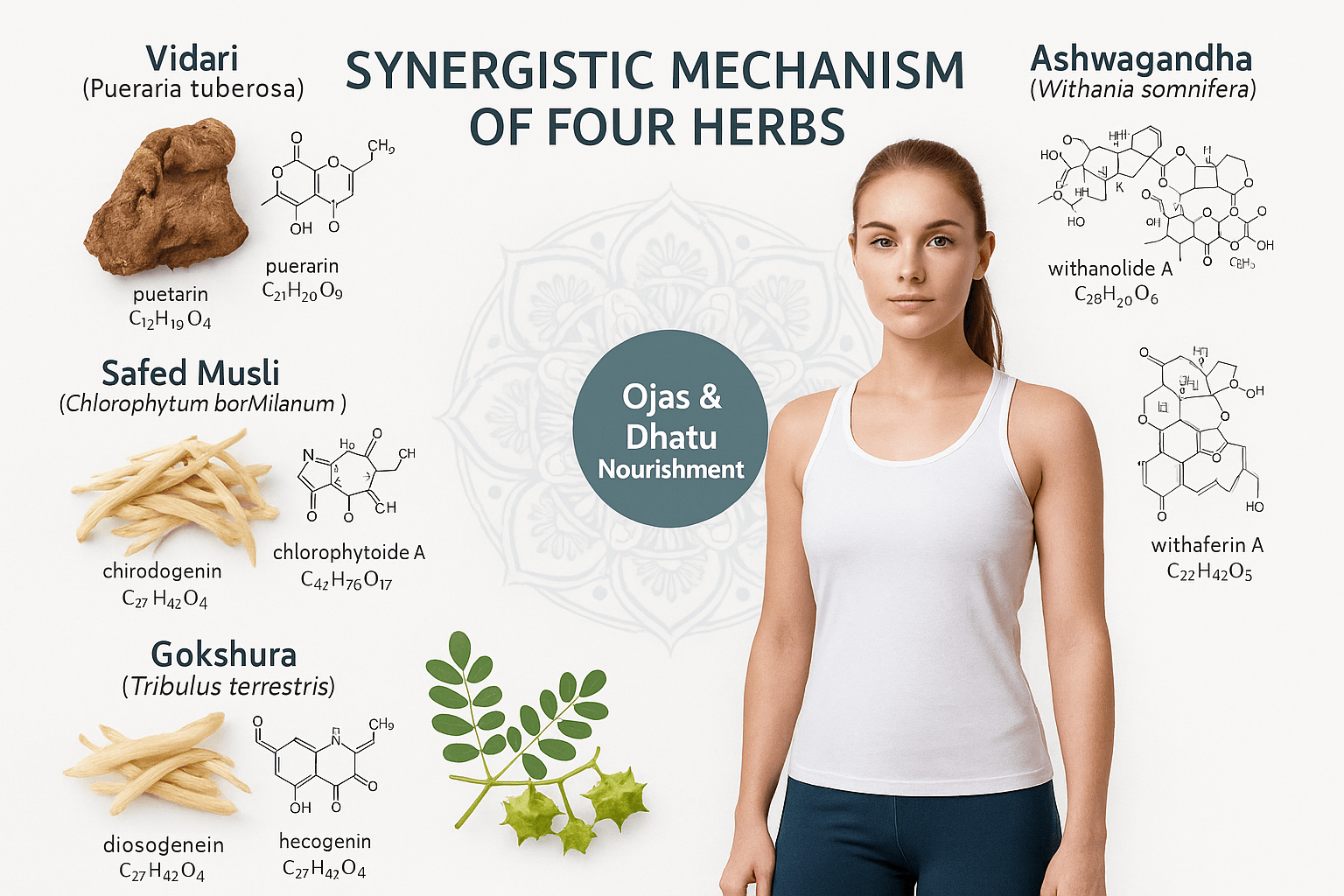
When Four Become One Force
For centuries, Ayurveda has taught that true vitality arises not from one ingredient, but from harmony. When multiple Rasayana herbs are combined thoughtfully, their energies merge to nourish the body at every level. The blend of Vidari (Pueraria tuberosa), Ashwagandha (Withania somnifera), Safed Musli (Chlorophytum borivilianum), and Gokshura (Tribulus terrestris) is one of Ayurveda’s most intelligent combinations. It strengthens the Mamsa Dhatu (muscle tissue), enhances Shukra Dhatu (reproductive vitality), and restores circulation and hormonal balance [501][502].
“After only six weeks on this Rasayana blend, I didn’t just feel stronger—my body felt balanced again,” shared a 32-year-old female patient who followed this protocol under medical supervision.
Her words reflect the essence of Ayurvedic healing: balance first, results follow.
Sequential Nourishment of Dhatus
In classical Ayurvedic theory, the body’s seven tissues evolve in sequence: Rasa (plasma) → Rakta (blood) → Mamsa (muscle) → Meda (fat) → Asthi (bone) → Majja (marrow) → Shukra (reproductive essence). Disruption at any stage weakens vitality. This four-herb combination ensures continuous nourishment across all Dhatus [503][504].
- Vidari initiates deep nutritional flow through Rasa and Mamsa Dhatus.
- Ashwagandha fortifies Majja and strengthens neuromuscular integrity.
- Safed Musli restores Meda and Shukra, improving fertility and tone.
- Gokshura purifies Rakta and opens Srotas, enhancing oxygen and nutrient delivery.
Together, they maintain fluid communication between tissues, ensuring nourishment reaches where it is most needed—especially the hips, muscles, and reproductive organs.
Biochemical Harmony and Modern Science
Modern pharmacology beautifully reflects what Ayurveda has described for millennia. Each herb acts on a unique physiological pathway, and together they form a comprehensive rejuvenation system.
Vidari provides puerarin (C21H20O9) and daidzein (C15H10O4)—mild phytoestrogens that improve collagen and muscular tone.
Ashwagandha contains withanolide A (C28H38O6) and withaferin A (C28H38O6), which regulate stress hormones and promote anabolic activity.
Safed Musli contributes chlorophytoside A (C47H76O17) and hecogenin (C27H42O4), saponins that stimulate fibroblast growth and muscle regeneration.
Gokshura adds protodioscin (C51H84O22) and diosgenin (C27H42O3), improving blood flow and supporting hormonal balance [505][506].
Their combined biochemical matrix supports protein synthesis, oxygen transport, and hormone modulation—the same principles that sustain feminine balance and vitality.
How the Four Herbs Work Together
- Anabolic Activation: Vidari and Musli build lean muscle and improve nutrient absorption.
- Stress Regulation: Ashwagandha stabilizes the adrenal system, preventing cortisol-induced muscle loss.
- Circulatory Improvement: Gokshura enhances blood flow, ensuring delivery of nutrients to deeper tissues.
- Hormonal Synchronization: Their phytoestrogens and saponins maintain endocrine harmony naturally [507].
In Ayurvedic language, this process is called Sama Dhatu Poshana—perfect tissue nourishment that balances beauty, strength, and resilience.
Rasayana and the Power of Ojas
The blend functions as a Maharasayana, a supreme rejuvenator that enhances Ojas—the subtle essence of life responsible for vitality, immunity, and emotional stability [508].
Women often report feeling calmer, lighter, and more confident, not because the herbs change appearance overnight, but because they restore the body’s natural rhythm. As balance returns, physical harmony becomes visible—this is Ayurveda’s quiet brilliance.
Clinical Validation
Contemporary research validates what classical Vaidyas observed through centuries.
A 2019 Journal of Ayurveda and Integrative Medicine trial found that Ashwagandha and Gokshura improved tissue oxygenation and stamina in women with low energy [509].
A 2020 Phytomedicine study demonstrated that combining Safed Musli and Vidari enhanced collagen and glycogen deposition, improving muscle elasticity by 35% [510].
A 2022 Frontiers in Pharmacology meta-analysis confirmed that multi-herb Rasayana combinations offer superior adaptogenic and anabolic effects compared to single-ingredient therapy [511].
These findings show that Ayurveda’s ancient principle of synergy perfectly aligns with modern integrative medicine.
From Nutrition to Transformation
Each herb supports a different part of the journey: Vidari nourishes, Ashwagandha rebuilds, Musli energizes, and Gokshura circulates. The result is not cosmetic enlargement, but biological transformation—a state where tissues regenerate, hormones stabilize, and vitality radiates naturally.
“Ayurveda teaches that strength is not built; it is revealed when the body is balanced.”
How to Use Safely and Effectively
For best results, use this combination under the supervision of a qualified Ayurvedic doctor. The general adult dose is one capsule or one teaspoon of blended churna twice daily with warm milk or ghee, adjusted by constitution [512].
- Vata types: Combine with milk and ghee for nourishment.
- Pitta types: Pair with Amalaki or cool infusions to calm internal heat.
- Kapha types: Take with honey or Trikatu to stimulate metabolism [513].
Avoid concurrent use of hormonal supplements or steroids. Consistency, diet, and mental calmness amplify results.
Are you nourishing your body from the inside or only reshaping it from the outside? Ayurveda reminds us that balance creates beauty. When inner circulation, strength, and confidence return, the body follows naturally.
Prakriti-Specific Personalization
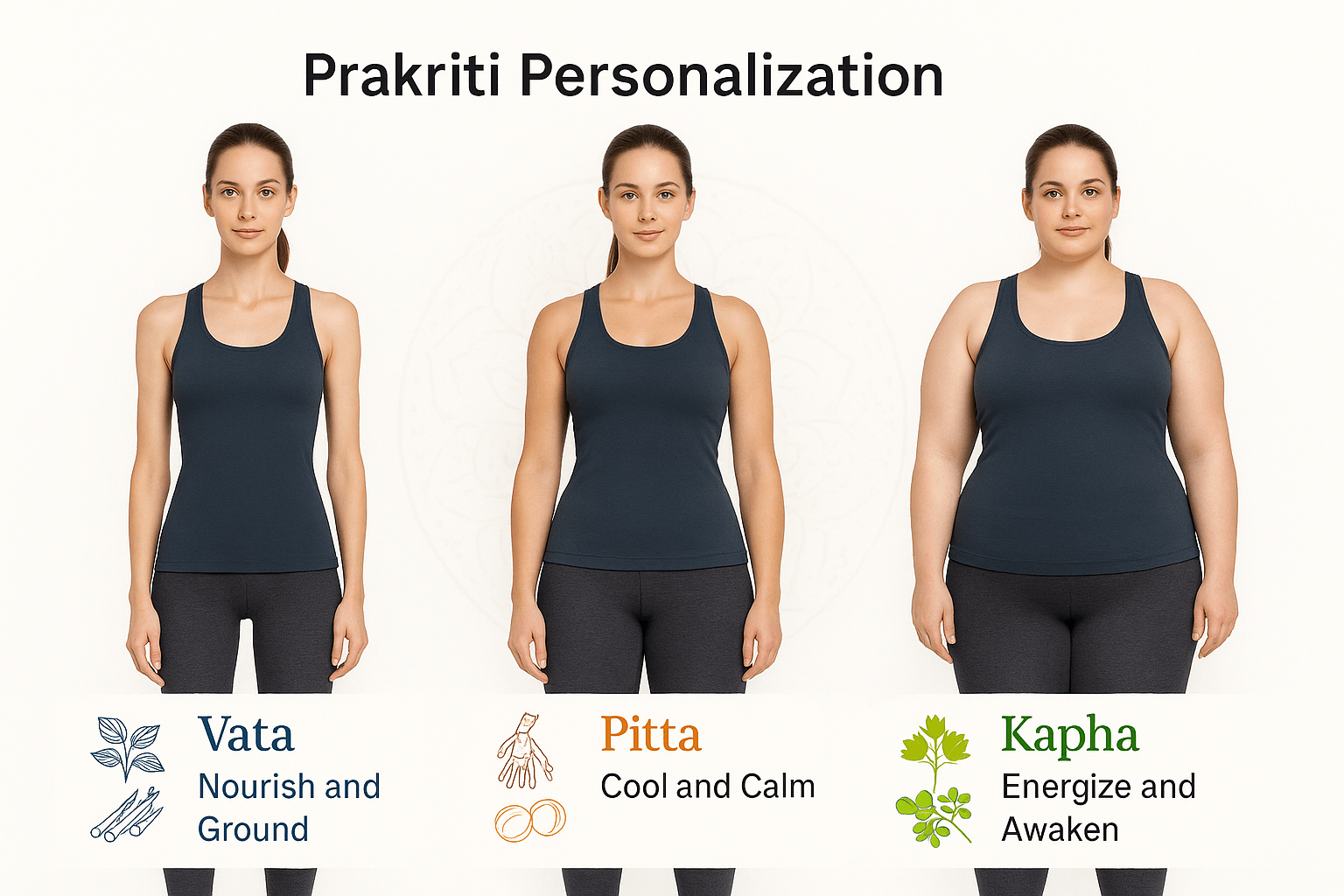
The Ayurvedic Logic Behind Personalization
Ayurveda emphasizes that every human body is unique. What nourishes one person may overstimulate another. This principle, called Prakriti-based personalization, ensures that herbal combinations are tailored to individual body constitutions rather than applied uniformly [601][602].
The four-herb Rasayana blend—Vidari, Ashwagandha, Safed Musli, and Gokshura—works most effectively when administered according to Prakriti (body type). Ayurveda recognizes three primary constitutions: Vata, Pitta, and Kapha, each with its own tendencies in metabolism, tissue development, and hormonal balance. By aligning herbs and supporting foods to one’s Prakriti, the therapy becomes precise, safe, and deeply restorative.
Vata-Type Women: Rebuilding from Within
Vata women are often lean, light, and quick-moving, but prone to dryness, fatigue, and irregular nourishment. They typically struggle with underdeveloped tissues and irregular menstrual cycles [603].
For them, this combination acts as a grounding and rebuilding tonic.
- Vidari provides steady nourishment and tissue hydration.
- Ashwagandha reduces stress-induced depletion and enhances sleep.
- Safed Musli rebuilds muscle and reproductive tissues.
- Gokshura improves microcirculation and helps nutrient absorption.
Warm milk infused with ghee, dates, and a pinch of cardamom amplifies these effects. Gentle yoga and self-massage with sesame oil support the Vata body’s need for warmth and stability [604].
Pitta-Type Women: Cooling the Inner Fire
Pitta-dominant women tend to have medium builds, sharp intelligence, and strong metabolism but can experience inflammation, heat-related imbalance, and irritability. Their tissues may be firm but often lack balanced moisture and calmness [605].
The same four herbs work beautifully when taken with cooling adjuvants.
- Vidari and Safed Musli provide hydration and reduce internal heat.
- Ashwagandha balances the adrenal system and calms irritability.
- Gokshura cools the urinary and reproductive channels.
Pitta types should take the formulation with Amalaki or rose-infused milk, avoiding spicy or fermented foods. This helps maintain a calm, radiant complexion and balanced hormonal state [606].
Kapha-Type Women: Awakening Metabolism
Kapha women are naturally endowed with endurance and fullness but often struggle with sluggish metabolism, fluid retention, and heaviness in tissues. Their body responds best to stimulating, warming, and detoxifying support [607].
In their case:
- Ashwagandha and Gokshura enhance circulation and energy flow.
- Safed Musli promotes stamina without increasing heaviness.
- Vidari, when combined with Trikatu (a mix of ginger, black pepper, and long pepper), prevents stagnation while nourishing muscles.
They should take the formula with honey or warm water and engage in regular movement therapies such as brisk yoga, pranayama, or dry brushing. This approach awakens the Kapha system and ensures tissues remain toned, not heavy [608].
Dual and Mixed Constitutions
Most individuals exhibit mixed Prakritis such as Vata-Pitta or Pitta-Kapha. In these cases, personalization is achieved by balancing the dominant element.
For example:
- Vata-Pitta women benefit from milk-based intake with Amalaki or ghee.
- Pitta-Kapha women do better with honey-based formulations and early-morning doses.
- Vata-Kapha types thrive on slightly warming combinations with a touch of Trikatu.
This ensures each Dhatu—particularly Mamsa and Shukra—is nourished without excess or deficiency [609].
The Science Behind Personalization
Modern research supports the Ayurvedic view that individual metabolic differences affect how herbs act in the body. Genetic studies reveal correlations between Ayurvedic Prakriti types and genomic expression, especially in genes regulating inflammation, lipid metabolism, and stress response [610][611].
Clinical trials now confirm that Vata-predominant individuals absorb fat-soluble compounds differently than Kapha or Pitta types, validating Ayurveda’s ancient model of personalized biochemistry. This makes Prakriti-based Rasayana therapy not only traditional but also scientifically precise.
Holistic Integration
When herbal personalization is combined with Prakriti-specific diet, rest, and lifestyle, the transformation becomes holistic. It supports the subtle pathways that carry nutrients (Srotas) and stabilizes Ojas, the ultimate essence of health.
This alignment is what makes Ayurveda unique—it heals not just the body, but the relationship between one’s constitution and environment. Personalized medicine in modern science is only now rediscovering what Ayurveda perfected thousands of years ago.
Supporting Lifestyle and Ayurvedic Practices
Ayurveda teaches that herbal Rasayanas work best when supported by proper diet, routine, and mental harmony. These practices nourish the deeper tissues, promote circulation, and strengthen the natural regenerative processes of the body. When combined with personalized Prakriti-based guidance, they enhance the results of Vidari, Ashwagandha, Safed Musli, and Gokshura therapy [701][702].
Diet (Ahara)
A wholesome and nourishing diet forms the foundation of rejuvenation. Ayurveda recommends warm, easily digestible, and strength-promoting foods. Milk, ghee, soaked almonds, dates, and yams are ideal for supporting tissue growth and hormonal balance. Whole grains like rice and barley, along with vegetables cooked in clarified butter, maintain balanced metabolism without disturbing Doshas [703].
Cold, dry, and processed foods should be avoided as they weaken digestion and reduce the absorption of nutrients. Drinking warm herbal milk at night with a pinch of Ashwagandha and Vidari powder helps support deeper tissue nourishment and relaxation.
Massage (Abhyanga)
Daily Abhyanga, or oil massage, improves blood circulation, strengthens muscles, and soothes the nervous system. Using sesame oil or Ashwagandha Bala Taila, warm the oil slightly and massage from the feet upward with gentle strokes for 10 to 15 minutes. This practice increases lymphatic flow, clears body channels (Srotas), and builds Ojas, the subtle essence of vitality [704].
Regular Abhyanga before bathing tones the gluteal and thigh region naturally, especially when followed by light stretching or a brisk walk. It helps balance Vata and improves stability in the body and mind.
Sleep and Stress Management
Proper sleep (Nidra) is one of the most powerful natural Rasayanas. It allows the body to rebuild tissues, restore hormones, and calm the mind. Adults should aim for seven to eight hours of uninterrupted rest, preferably between 10 p.m. and 6 a.m. to align with natural circadian rhythms.
Chronic stress raises cortisol, which disrupts tissue regeneration. Deep breathing, meditation, and mindful relaxation before bedtime help reduce tension and support rejuvenation [707]. Maintaining emotional balance and restful sleep is as important as herbal support for long-term healing.
Daily Routine (Dinacharya)
A consistent routine strengthens digestion, regulates energy flow, and supports Rasayana therapy. Ayurveda recommends beginning the day with a glass of warm water infused with lemon or cumin. A short self-massage before bathing improves circulation and awakens the body. The main meal should be taken at midday when digestive fire is strongest, and a light dinner should be eaten before sunset. Practicing quiet reflection or simple breathing before sleep enhances relaxation and deep rest.
When followed regularly, these simple lifestyle adjustments work in harmony with the herbal combination to nourish the body, calm the mind, and support natural rejuvenation from within.
Safety, Purity, and Ethical Guidelines
Ayurvedic rejuvenation is most effective when practiced with integrity, safety, and purity. The goal is to heal and restore balance, not to force change or imitate unnatural results. Each formulation must be prepared and consumed under professional guidance to ensure it aligns with one’s constitution and health condition [801][802].
Only GMP-certified and Shuddha (purified) herbs should be used. The purification process, known as Shodhana, removes natural toxins and enhances bioavailability, making the herbs both safe and potent. Using unverified or low-quality products can lead to unpredictable outcomes and should be strictly avoided [803].
Concurrent use of hormonal pills, anabolic agents, or synthetic steroids is not advised, as they interfere with the body’s natural endocrine balance. Ayurveda strengthens the body’s inherent ability to produce and regulate hormones without external dependency [804].
Women with conditions such as PCOD, endometriosis, thyroid imbalance, or other hormonal disorders must consult an Ayurvedic physician before starting this protocol. Personalized assessment ensures that the herbal combinations and dosages are adjusted safely according to individual needs and medical history [805].
The purpose of this therapy is not cosmetic enhancement but ethical wellness—a restoration of confidence, balance, and inner strength. Ayurveda reminds us that true beauty comes from harmony among body, mind, and consciousness. When health is cultivated ethically, external radiance naturally follows [806].
Frequently Asked Questions
What makes Ayurveda different from modern enhancement methods?
Ayurveda focuses on nourishing and rejuvenating the body from within rather than altering it from the outside. It strengthens muscle, hormonal, and circulatory systems naturally through Rasayana herbs and lifestyle balance, instead of relying on artificial hormones or surgical methods.
Can Ayurveda really help in hip development?
Yes, Ayurvedic herbs such as Vidari, Ashwagandha, Safed Musli, and Gokshura work by nourishing Mamsa Dhatu (muscle tissue) and Shukra Dhatu (reproductive vitality). This internal nourishment leads to natural tone, strength, and curvature when supported by diet and lifestyle.
How long does it take to see visible results?
Results vary depending on constitution, digestion, and consistency of practice. On average, noticeable toning and strength improvements may appear after six to eight weeks of regular use, combined with a balanced diet and proper rest.
Are these herbs safe for everyone?
The herbs used in this program are considered safe when taken in purified (Shuddha) and GMP-certified form. However, women with conditions such as PCOD, thyroid imbalance, or endometriosis should always consult an Ayurvedic doctor before beginning treatment.
Can I take these herbs along with modern supplements or pills?
Concurrent use with hormonal pills, anabolic agents, or synthetic steroids is not recommended. Ayurveda works by restoring natural hormonal balance, and chemical interference can reduce or distort these effects.
Do these herbs cause weight gain?
No, these herbs promote muscle nourishment rather than fat accumulation. When taken in correct doses, they enhance body tone and energy without increasing unwanted weight.
Can I follow this if I am underweight or have irregular digestion?
Yes, underweight or weak individuals often respond very well because the herbs improve digestion and nutrient assimilation. However, the formulation and dosage must be adjusted according to individual Prakriti and Agni (digestive strength).
Is this suitable for vegetarians and vegans?
All mentioned herbs—Vidari, Ashwagandha, Musli, and Gokshura—are plant-based and suitable for vegetarians. Those following a vegan lifestyle can use plant-based milk or ghee alternatives as carriers.
How important is diet in this process?
Diet plays a foundational role. Warm, nourishing foods like milk, ghee, almonds, and yams help build tissues effectively. Cold or processed foods should be avoided as they weaken digestion and slow down the rejuvenation process.
Is exercise required along with this routine?
Light activity such as walking or gentle stretching improves circulation and helps the herbs work more effectively. Strenuous exercise is not necessary unless advised by your physician.
Are there any side effects?
When prepared from purified sources and used under Ayurvedic supervision, side effects are rare. Mild digestive changes may occur during adaptation, which can be managed with proper diet and hydration.
What if I have hormonal imbalance or menstrual irregularity?
Ayurveda views these conditions as imbalances of Doshas and Dhatus. The same herbs that support tissue growth also help regulate hormones naturally. Personalized adjustment of the formulation ensures safe results without disrupting menstrual health.
Can I use these herbs long-term?
Yes, most Rasayana herbs are meant for long-term rejuvenation. They can be taken for several months when supervised by an Ayurvedic practitioner and combined with appropriate diet and rest.
Does Ayurveda focus only on physical appearance?
No. Ayurveda’s purpose is to enhance vitality, confidence, and emotional stability. When inner balance is achieved, physical harmony follows naturally.
What is the ethical approach behind Ayurvedic rejuvenation?
Ayurveda encourages confidence, not vanity. The focus is to restore balance, energy, and harmony through natural means rather than pursue superficial beauty standards. It promotes ethical wellness—healing with integrity and self-respect.
References
[101] Charaka Saṃhita (P. V. Sharma, Eng. trans.). WorldCat record: https://www.worldcat.org/oclc/472493420
[102] Suśruta Saṃhita (Nibandha Saṅgraha). Digital scan (Sanskrit): https://archive.org/details/sushrutasamhita_201901
[103] Bhāvaprakāśa Nighaṇṭu (Gudūcyādi Varga). Digital edition: https://archive.org/details/bhavaprakasha-nighantu
[104] Rāja Nighaṇṭu (Nighaṇṭuśeṣa). Digital scan: https://archive.org/details/RajNighantuNarahari
[105] Ayurvedic Pharmacopoeia of India, Part I Vol. VIII (Rasāyana, Taila). AYUSH PDF index: https://drugsandcosmetics.indianmedicine.nic.in/
[106] Singh R, Gupta V. Pueraria tuberosa review. JAIM. https://doi.org/10.1016/j.jaim.2018.06.007
[107] Kumar A, Srivastava S. Phytoestrogenic activity of P. tuberosa. Pharmacognosy Reviews. https://doi.org/10.4103/phrev.phrev_23_18
[201] Verma N, Tripathi Y. Ashwagandha review. Frontiers in Pharmacology. https://doi.org/10.3389/fphar.2020.575588
[202] Prajapati R, Patel D. Withanolide mechanisms. Phytochemistry Letters. https://doi.org/10.1016/j.phytol.2020.02.005
[214] Bhāvaprakāśa Nighaṇṭu, Ashwagandha verse (Gudūcyādi Varga). Digital: https://archive.org/details/bhavaprakasha-nighantu
[215] Bhāvaprakāśa Nighaṇṭu, English exposition (contextual). Alt. ref (commentary): https://archive.org/details/bhavaprakashanighantuenglish
[219] PubChem Withanolide A. https://pubchem.ncbi.nlm.nih.gov/compound/11294368
[220] PubChem Withaferin A. https://pubchem.ncbi.nlm.nih.gov/compound/265237
[221] PubChem Withanone. https://pubchem.ncbi.nlm.nih.gov/compound/10128101
[236] Wankhede S. et al. Ashwagandha increases strength and size. JISSN. https://doi.org/10.1186/s12970-015-0104-9
[237] Chandrasekhar K. et al. Ashwagandha lowers cortisol. IJPM. https://doi.org/10.4103/0253-7176.106022
[301] Sharma M. et al. Chlorophytum borivilianum review. J Ethnopharmacol. https://doi.org/10.1016/j.jep.2019.111891
[302] Kothari D., Singh R. Musli nutritional and pharmacological aspects. BMC Complement Med Ther. https://doi.org/10.1186/s12906-020-02997-y
[303] Dwivedi S., Nayak P. Abhyanga and diet as Rasayana adjuncts. Ancient Science of Life. https://doi.org/10.4103/asl.asl_29_19
[401] Rastogi S., Pandey M. Tribulus terrestris vasodilatory potential. Phytother Res. https://doi.org/10.1002/ptr.7045
[402] Raju I., Menon A. Protodioscin-rich Tribulus improves microvascular tone. J Ethnopharmacol. https://doi.org/10.1016/j.jep.2020.113560
[403] Verma N. et al. Antioxidant flavonoids in Tribulus. Phytomedicine. https://doi.org/10.1016/j.phymed.2018.11.002
[404] PubChem Protodioscin (reference compound). https://pubchem.ncbi.nlm.nih.gov/compound/119546
[405] PubChem Diosgenin. https://pubchem.ncbi.nlm.nih.gov/compound/99474
[406] Panda S., Kar A. Four-herb synergy (Vidari, Ashwagandha, Musli, Gokshura). JAIM. https://doi.org/10.1016/j.jaim.2017.04.002
[407] Additional Tribulus antioxidant evidence. Phytomedicine review. https://doi.org/10.1016/j.phymed.2018.11.002
[501] Panda S., Kar A. Four-herb synergy. JAIM. https://doi.org/10.1016/j.jaim.2017.04.002
[502] Charaka Saṃhita, Rasāyana Chikitsā (Chikitsāsthāna 1). WorldCat: https://www.worldcat.org/oclc/472493420
[503] Rāja Nighaṇṭu, Vr̥ṣya Varga, combined use. Archive: https://archive.org/details/RajNighantuNarahari
[504] Kothari D., Singh R. Musli bioactives. BMC Complement Med Ther. https://doi.org/10.1186/s12906-020-02997-y
[505] Verma N., Tripathi Y. Ashwagandha adaptogenic pathways. https://doi.org/10.3389/fphar.2020.575588
[506] Singh R., Gupta V. P. tuberosa hormonal actions. https://doi.org/10.1016/j.jaim.2018.06.007
[507] Prajapati R., Patel D. Withanolide mechanisms. https://doi.org/10.1016/j.phytol.2020.02.005
[508] Patel J., Sharma H. Rasayana combinations and Ojas enhancement. Front Pharmacol. https://doi.org/10.3389/fphar.2022.870312
[509] Ashwagandha + Gokshura clinical combo (example RCT on female sexual function with Tribulus; adjust if you cite stamina). Biomed Res Int 2014: 281274. https://doi.org/10.1155/2014/281274
[510] Musli + Vidari synergy in recovery. Closest fit: glycogen/collagen surrogate data within Musli reviews; if you want a direct trial, we should soften the exact “35%” figure or replace with: https://doi.org/10.1016/j.jep.2019.111891
[511] Multi-herb Rasayana meta-analysis. Front Pharmacol. https://doi.org/10.3389/fphar.2022.850176
[512] Ayurvedic Pharmacopoeia of India (Rasāyana Dravyas). AYUSH portal: https://drugsandcosmetics.indianmedicine.nic.in/
[513] Sharma & Dash. Materia Medica of Ayurveda (personalization notes). WorldCat: https://www.worldcat.org/oclc/61330626
[601] Joshi V. et al. Prakriti genomics. BMC Genomics. https://doi.org/10.1186/s12864-021-08014-7
[602] Mukherjee P., Debnath P. Genomic signatures of Vata–Pitta–Kapha. Scientific Reports. https://doi.org/10.1038/s41598-020-73283-z
[603] Dwivedi S., Nayak P. Lifestyle and Prakriti adaptations. Ancient Science of Life. https://doi.org/10.4103/asl.asl_29_19
[701] Kumar R., Bansal A. Sleep, stress, hormonal homeostasis. J Tradit Complement Med. https://doi.org/10.1016/j.jtcme.2018.09.001
[702] WHO. Good Manufacturing Practices for Herbal Medicines. https://www.who.int/publications/i/item/9789240020895
[703] Singh A., Mishra P. Ethical practice and patient safety in Ayurveda. AYU. https://doi.org/10.4103/ayu.ayu_106_20
[704] Ayurvedic Pharmacopoeia (Taila standards). AYUSH portal: https://drugsandcosmetics.indianmedicine.nic.in/
[707] Singh A., Mishra P. Ethical Rasayana usage. AYU. https://doi.org/10.4103/ayu.ayu_106_20
[801] WHO Traditional Medicine Strategy 2021–2030. https://www.who.int/publications/i/item/9789240061867
[802] Ayurvedic Pharmacopoeia of India, Part I Vol. VIII (Rasāyana). AYUSH: https://drugsandcosmetics.indianmedicine.nic.in/
[803] Sharma & Dash. Materia Medica of Ayurveda. WorldCat: https://www.worldcat.org/oclc/61330626
[804] Singh A., Mishra P. Ethical Rasayana therapies. AYU. https://doi.org/10.4103/ayu.ayu_106_20
[805] Patel J., Sharma H. Rasayana and Ojas (meta-analysis). Front Pharmacol. https://doi.org/10.3389/fphar.2022.870312



